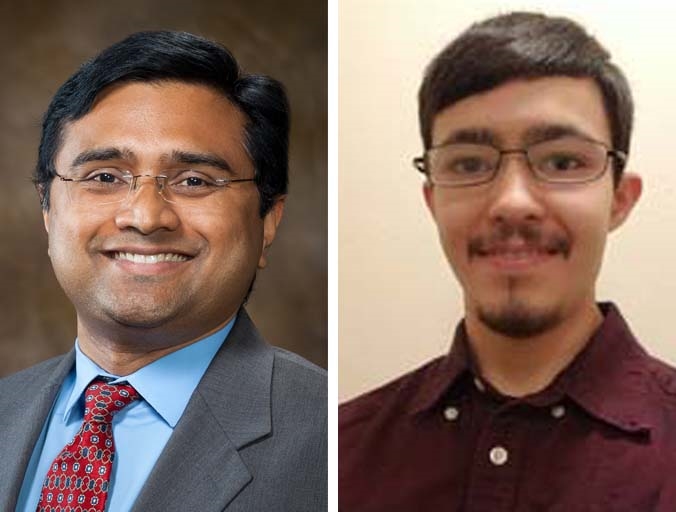Research Identifies Nanoscale Effect of Water and Mineral Content on Bone
FAYETTEVILLE, Ark. – University of Arkansas researchers Marco Fielder and Arun Nair have conducted the first study of the combined nanoscale effects of water and mineral content on the deformation mechanisms and thermal properties of collagen, the essence of bone material.
The researchers also compared the results to the same properties of non-mineralized collagen reinforced with carbon nanotubes, which have shown promise as a reinforcing material for bio-composites. This research aids in the development of synthetic materials to mimic bone.
Using molecular dynamics — in this case a computer simulation of the physical movements of atoms and molecules — Nair and Fielder examined the mechanics and thermal properties of collagen-based bio-composites containing different weight percentages of minerals, water and carbon nanotubes when subjected to external loads.
They found that variations of water and mineral content had a strong impact on the mechanical behavior and properties of the bio-composites, the structure of which mimics nanoscale bone composition. With increased hydration, the bio-composites became more vulnerable to stress. Additionally, Nair and Fielder found that the presence of carbon nanotubes in non-mineralized collagen reduced the deformation of the gap regions.
The researchers also tested stiffness, which is the standard measurement of a material’s resistance to deformation. Both mineralized and non-mineralized collagen bio-composites demonstrated less stability with greater water content. Composites with 40% mineralization were twice as strong as those without minerals, regardless of the amount of water content. Stiffness of composites with carbon nanotubes was comparable to that of the mineralized collagen.
“As the degree of mineralization or carbon nanotube content of the collagenous bio-composites increased, the effect of water to change the magnitude of deformation decreased,” Fielder said.
The bio-composites made of collagen and carbon nanotubes were also found to have a higher specific heat than the studied mineralized collagen bio-composites, making them more likely to be resistant to thermal damage that could occur during implantation or functional use of the composite. Like most biological materials, bone is a hierarchical – with different structures at different length scales. At the microscale level, bone is made of collagen fibers, composed of smaller nanofibers called fibrils, which are a composite of collagen proteins, mineralized crystals called apatite and water. Collagen fibrils overlap each other in some areas and are separated by gaps in other areas.
“Though several studies have characterized the mechanics of fibrils, the effects of variation and distribution of water and mineral content in fibril gap and overlap regions are unexplored,” said Nair, who is an associate professor of mechanical engineering. “Exploring these regions builds an understanding of the structure of bone, which is important for uncovering its material properties. If we understand these properties, we can design and build better bio-inspired materials and bio-composites.”
The researchers’ findings were published in Biomechanics and Modeling in Mechanobiology and International Biomechanics.
The computer simulations were performed using Arkansas High Performance Computing Center at the University of Arkansas.
Nair holds the 21st Century Professorship in Mechanical Engineering. Fielder is a Doctoral Academy Fellow and doctoral candidate in the university’s Materials Science and Engineering Program.
About the University of Arkansas: The University of Arkansas provides an internationally competitive education for undergraduate and graduate students in more than 200 academic programs. The university contributes new knowledge, economic development, basic and applied research, and creative activity while also providing service to academic and professional disciplines. The Carnegie Foundation classifies the University of Arkansas among only 3 percent of colleges and universities in America that have the highest level of research activity. U.S. News & World Report ranks the University of Arkansas among its top American public research universities. Founded in 1871, the University of Arkansas comprises 10 colleges and schools and maintains a low student-to-faculty ratio that promotes personal attention and close mentoring.
Topics
Contacts
Arun Nair, associate professor
Department of Mechanical Engineering
479-575-2573,
dmcgowa@uark.edu
Matt McGowan, science and research communications officer
University Relations
479-575-4246,
dmcgowa@uark.edu
Headlines
PetSmart CEO J.K. Symancyk to Speak at Walton College Commencement
J.K. Symancyk is an alumnus of the Sam M. Walton College of Business and serves on the Dean’s Executive Advisory Board.
Faulkner Center, Arkansas PBS Partner to Screen Documentary 'Gospel'
The Faulkner Performing Arts Center will host a screening of Gospel, a documentary exploring the origin of Black spirituality through sermon and song, in partnership with Arkansas PBS at 7:30 p.m. Thursday, May 2.
UAPD Officers Mills and Edwards Honored With New Roles
Veterans of the U of A Police Department, Matt Mills has been promoted to assistant chief, and Crandall Edwards has been promoted to administrative captain.
Community Design Center's Greenway Urbanism Project Wins LIV Hospitality Design Award
"Greenway Urbanism" is one of six urban strategies proposed under the Framework Plan for Cherokee Village, a project that received funding through an Our Town grant from the National Endowment for the Arts.
Spring Bike Drive Refurbishes Old Bikes for New Students
All donated bikes will be given to Pedal It Forward, a local nonprofit that will refurbish your bike and return it to the U of A campus to be gifted to a student in need. Hundreds of students have already benefited.





